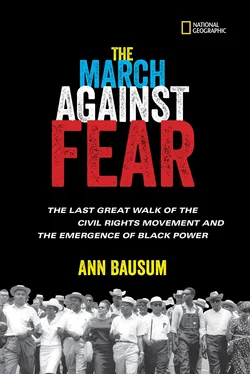The battle to integrate Ole Miss took place during the opening years of a growing movement for African-American civil rights. Meredith’s hard-fought success served as one more piece of evidence that change could take place in the Deep South. By the time he graduated, the civil rights movement had grown into a national force for social justice, with multiple organizations working to break down the rule of white supremacy. The same month that Meredith graduated from Ole Miss, for example, movement leaders mounted the historic March on Washington and its culminating “I Have a Dream” speech by Martin Luther King, Jr., who had become a towering figure in the struggle for racial equality.
A cornerstone of this social justice movement became the willingness of people to put their lives on the line in the fight for change, much as Meredith had done during the integration of Ole Miss. Volunteers in the movement countered the violence of segregationists with tremendous acts of courage. They stood their ground peacefully in the midst of racist attacks, confident that love was a more powerful emotion than hate. Year after year, they persevered, whether it meant walking to work instead of riding segregated buses during the Montgomery bus boycott of 1955 and 1956, or braving violent mobs during the freedom rides of 1961, or enduring police attacks with high-pressure fire hoses during the Birmingham campaign of 1963.
Such efforts drew on what movement leaders called the power of nonviolence. Some viewed nonviolence as a strategy, a series of tactics that forced reluctant foes to submit to change; others saw it as a way of life. For nonviolence to work, people had to be willing to remain peaceful, but determined, in the face of any level of violence. They had to outmaneuver their violent oppressors and step in and complete a protest whether their comrades had been arrested, injured, or even killed.
During 1965, after segregationists murdered a black youth who had advocated with others in Selma, Alabama, for equal voting rights, civil rights leaders vowed to carry on the young man’s fight by walking from there to the state capital of Montgomery, 54 miles away. King, other leaders, and their supporters made the march to demonstrate their determination to end the discriminatory practices that had kept blacks from voting in the South for nearly a century. The walk from Selma to Montgomery had become a triumphant procession that spring, lasting five days. The march’s compelling demonstration of the power of nonviolence had helped to secure passage later that year of the Voting Rights Act of 1965, federal legislation which finally ensured universal access to voting in the South, regardless of race.
Meredith remained on the sidelines during all of these developments. Although he could have joined forces with the civil rights movement after he earned his degree from Ole Miss, Meredith chose to maintain his independence and to focus on his own goals. While others were protesting for civil rights, he obtained further education. First he accepted an invitation from the government of Nigeria to study abroad. Meredith was intrigued by the opportunity to see how blacks lived on a different continent, and in early 1964 he moved to Africa with his wife and young son. The following year he ended his studies as a graduate student at the University of Ibadan and returned to the United States so he could enroll in law school at Columbia University in New York City.
After integrating Ole Miss, Meredith had developed a reputation within the civil rights movement for being a quirky loner. Fiercely independent, he could be feisty and impulsive. He had a tendency to make provocative statements and to seem dismissive of the work of other activists. Movement leaders eyed him cautiously as a result, never sure if they could count on his support. Meredith kept his distance from the movement; it didn’t suit his personality or his mind-set to immerse himself in such a broad campaign. He preferred to be in control.
As a military veteran, Meredith still thought like a soldier. He trusted the power of hierarchy, discipline, and military-style precision more than the power of nonviolence. He embraced the era’s more traditional view of manhood, believing that men proved their worth with courageous behavior. Meredith disliked the civil rights movement’s strategy of including women and children in their protests. He thought that doing so made men weak. The women and children appeared to be shields, protecting the men from attack. Shouldn’t it be the other way around, he thought. Shouldn’t men be brave enough to stand up for their rights on their own, as he had done at Ole Miss?
This visionary man toggled back and forth between two styles of thought. On the one hand, Meredith thought strategically. Join the military. Get an education. Start a family. On the other hand, he had outsize plans for himself, such as integrating an iconic all-white fortress of education. By combining his skills at strategic planning with his ambitious vision, Meredith had accomplished remarkable feats. Few others could have endured his Ole Miss legal battle, student harassment, and threats of bodily harm. But he had. And why?
The answer was obvious to Meredith: It was his destiny.
Meredith acted with an unwavering confidence that he was fulfilling some predetermined plan to serve as a leader for the oppressed members of his race. That sense of destiny—what he called his divine responsibility—had inspired him to integrate Ole Miss, and in the spring of 1966 it led him to set a new challenge for himself and for the state of Mississippi. This time he wanted to battle something even bigger than Ole Miss, something even bigger than segregation. This time he wanted to battle fear, the fear that pulsed through so many racial interactions in the South. Meredith, age 32, maintained that he was tired of being afraid of white people. Furthermore, he wanted other blacks in his home state to stop being afraid of whites, too. If Mississippi’s African Americans could just stop being afraid, he suggested, everyone would be better off.
Meredith planned to fight fear with his feet. He’d take a walk, what he called a Walk Against Fear. That summer, after finishing his first year of law school, he would start walking in Memphis, Tennessee, just across the state line from Mississippi, and not stop until he’d reached Jackson, the state’s capital, some 220 miles away. Meredith didn’t see his hike as a protest; he saw it as something ordinary that anyone should be able to do. He credited his mother, Roxie, with inspiring the idea. The year before, she’d confided in him that she considered Meredith’s youngest brother to be in less danger while fighting in the Vietnam War with the U.S. military than he would have been if he’d stayed at home. Her statement had shocked Meredith. Maybe African Americans wouldn’t be so afraid in Mississippi, he’d concluded, if they had more control over the state’s governance.
For nearly a century, southern whites had denied blacks their share of political power by denying them their right to vote. But now, for the first time since the post–Civil War era of Reconstruction, the newly enacted Voting Rights Act of 1965 enforced rights that had been granted in 1870 with the 15th Amendment to the U.S. Constitution. A year after the latest legislation, though, the majority of the state’s African Americans had not yet registered to vote. The key remaining obstacle on that path, as Meredith saw it, was fear: fear of the consequences blacks might face if they chose to vote. By walking from Memphis to Jackson, Meredith hoped to inspire African Americans in his home state to become a bit less afraid. They, too, could take a walk against fear, a short walk that led to the ballot box.
Meredith speculated that the concerns of his mother and other southern blacks might be unwarranted, might be a lingering habit developed during earlier eras filled with real terror. Was their fear “just operating on its own accord”? Meredith wondered. And what about the white citizens of Mississippi? They were afraid, too, afraid that the advancement of one race meant the inevitable decline of another. That didn’t have to be so, Meredith believed. He’d try to prove his point and conquer his own inherited fears by walking through his home state.
Читать дальше












